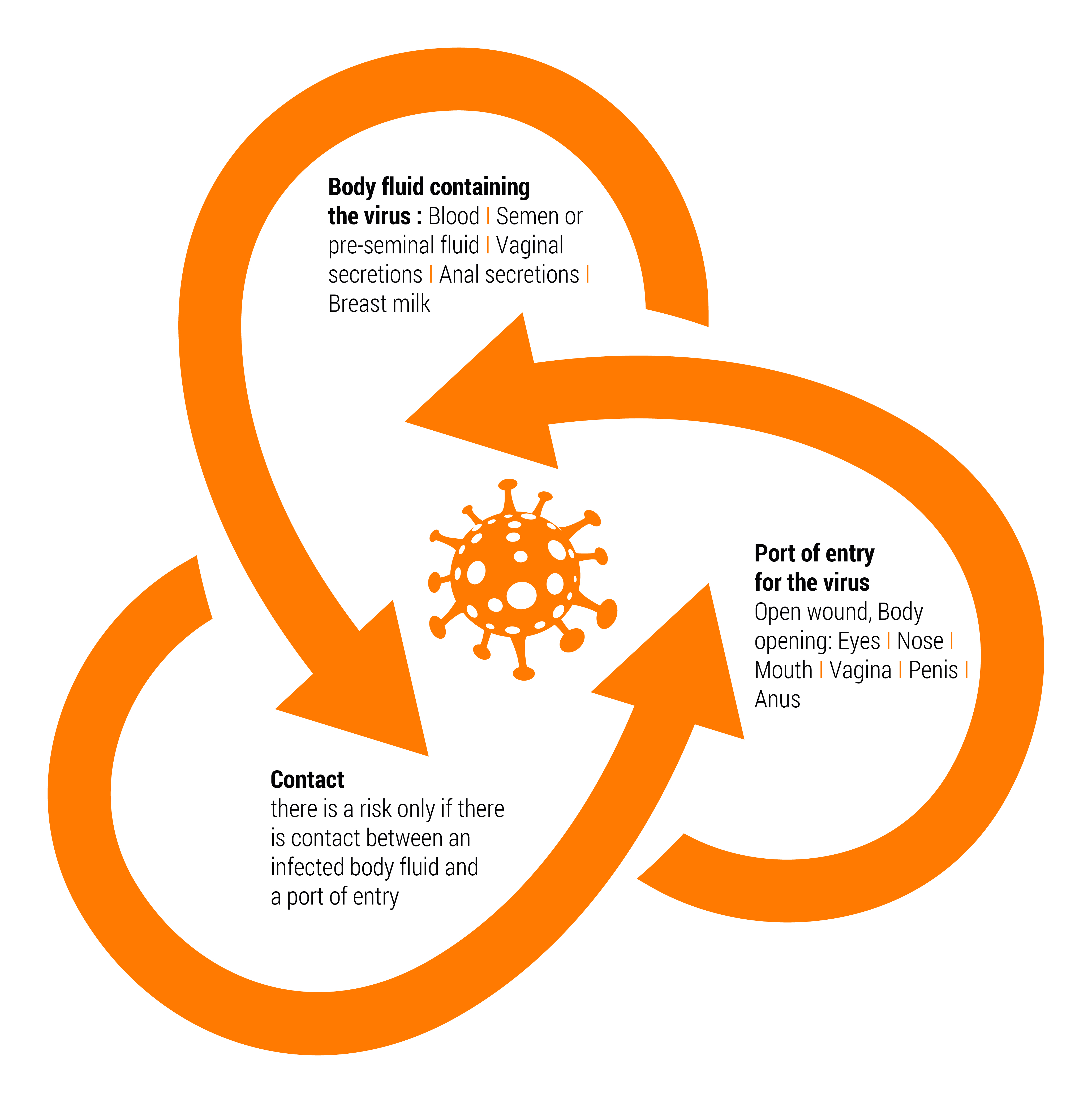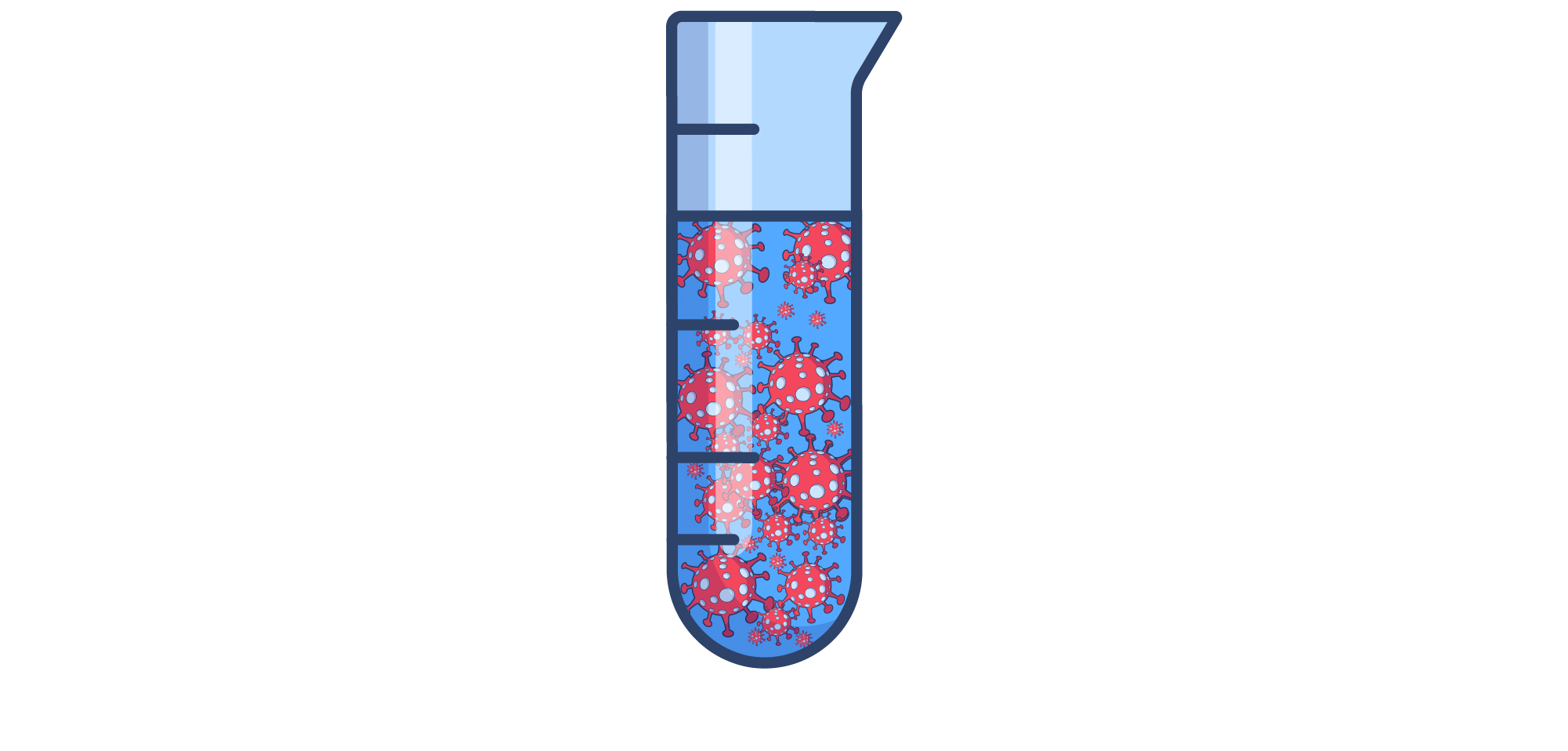Module 3 Libre : Les voies de transmission et les antirétroviraux
Module 3:
Contents
LEARNING OBJECTIVES
At the end of Module 3, the participant will be able to:Introduction:
HIV is present in all body fluids of a person living with HIV. Only 5 such fluids however contain a sufficient amount of virus for HIV transmission to occur:

Blood

Semen (including pre-seminal liquid)

Vaginal secretion

Breast milk

Anal secretions
HIV TRANSMISSION MODES:
The amount of virus in fluids, such as saliva, tears, urine or sweat, is too low for HIV to be transmitted.
THREE CONDITIONS MUST BE MET FOR THERE TO BE A RISK OF HIV TRANSMISSION:
- the presence of one of the five fluids containing a sufficiently large amount of virus for infection to be possible
- an opening in the body, a port of entry through which the virus can enter the bloodstream of an HIV-negative person
- an activity or event that leads to contact between the fluid and the port of entry

The risk of HIV transmission is real only if these three conditions are met.
Wounds


Mucous membranes


Activities or events that lead to contact between the fluid and the port of entry are:
.


.


.


.


Sexual transmission:
- There is a risk of HIV transmission during anal or vaginal sex. This risk is increased when the semen of a person living with HIV enters the vagina or anus.
- The risk also increases when there are STI lesions or injuries from rougher sex or rape.
- Fellatio (stimulation of the male sex with the mouth), cunnilingus (stimulation of the female sex with the mouth) anilingus (stimulation of the anus with the mouth) does not constitute a risk (saliva does not allow the transmission of HIV). There is a small risk however to the person performing oral sex when semen (fellatio) or blood (cunnilingus, anilingus) enters the mouth.
The risk of transmission also varies according to the viral load (amount of virus present) of the person living with HIV. The viral load is higher during seroconversion and during the AIDS stage, so the risk of transmitting HIV is consequently higher during these phases.
A person living with HIV who has an undetectable viral load - when the virus can no longer be detected in the blood under ARV - cannot transmit HIV sexually.
THERE IS NO RISK OF HIV TRANSMISSION:
- During everyday contact: shaking hands, kissing, touching, massaging...
- Living with a person who is HIV positive: sharing cooking utensils or dishes, using the same toilet, sharing clothes...
- Through insect bites
- During dental work, tattoos, piercings – provided hygiene rules are respected
- When the fluid containing HIV is outside the body and has dried up, it can no longer transmit HIV. The virus cannot swim or jump either.
What liquids can transmit hiv?
Through which openings / ports of entry can hiv enter the body?
What situations are risky?
Click on (i) of the image to get more information thereon.ANTIRETROVIRAL THERAPY
Antiretroviral (ARV) treatment is a drug therapy against (=anti) the (retro)virus) of the human immunodeficiency virus (HIV). HIV enters the CD4 lymphocytes (cells of the immune system), injects them with its genetic material (RNA - ribonucleic acid) and uses them to replicate. The new viruses will attack new CD4 cells and so on. As the amount of virus increases, the number of CD4s decreases and the immune system weakens.
Many drugs have been developed since 1983 to counter on one or other phase of HIV replication. For example, some antiretrovirals prevent the virus from entering the cell, others from replicating and spreading further in the body. Their effectiveness has been very limited and the side effects are considerable.
A combination of different drugs finally made a more effective action against the virus possible while limiting the emergence of resistance against the treatment. Before the end of the 1990s, getting infected with HIV usually meant dying of AIDS. Today, triple therapy, a combination or cocktail of three drugs that act in three different ways, can neutralize the replication process of the virus and reduce the amount of it in the body.
ACTION OF THE THERAPY:
Thanks to a viral load that can become undetectable following treatment (i.e. the amount of virus in the body decreases until it almost disappears), the immune system of HIV-positive people can be preserved (if the HIV infection is detected early) or restored, and thus ensure good health and avoid the AIDS stage.
It is important therefore to start treatment as soon as possible in order to preserve immunity against other diseases and infections. HIV infection can consequently be considered a chronic disease, and people living with HIV can achieve a good quality of life and a life expectancy close to that of HIV-negative people.
There is no treatment that can cure HIV or eliminate it completely from the body at this time however. HIV remains in the body for life and treatment must undergone daily. If the treatment is not taken regularly, resistance can develop, i.e. the virus can become resistant to the treatment, which then becomes less effective or no longer works.
Newer generations of drugs have far fewer side effects, but these are not excluded and the constant presence of the virus still has an impact on the body.
ROLE OF ANTIRETROVIRALS
Antiretrovirals (ARVs) can be used in different ways to prevent HIV transmission:
1. For people living with HIV, antiretroviral therapy
- prevents sexual transmission (TasP - treatment as prevention)
- greatly reduces the risk of mother-to-child transmission
2. For HIV-negative people, specific antiretroviral therapy regimens:
- reduce the risk of becoming infected with HIV after accidental exposure to the virus (PEP - post-exposure prophylaxis)
- reduce the risk of becoming infected with HIV during regular or planned exposure (PrEP - pre-exposure prophylaxis)
U = U: UNDETECTABLE = UNTRANSMISSIBLE



Today, an HIV-positive person can get treatment that makes the viral load, i.e. the presence of virus in the blood, undetectable!
A person living with HIV, under regular and effective antiretroviral treatment, with an undetectable viral load for at least 6 months, can no longer transmit the HIV virus sexually.
Hence the equation U = U: undetectable = untransmittable
Regular medical check-ups are still necessary to monitor whether the presence of the virus in the blood remains undetectable and to screen for other potential sexually transmitted infections (STIs).
The use of condoms remains the most effective way to protect against STIs and is also a means of contraception.

